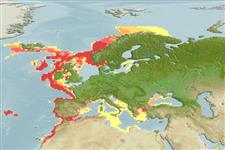Preferred temperature (Ref.
123201): 6.3 - 11.4, mean 7.7 °C (based on 165 cells).
Phylogenetic diversity index (Ref.
82804): PD
50 = 0.7520 [Uniqueness, from 0.5 = low to 2.0 = high].
Bayesian length-weight: a=0.00479 (0.00377 - 0.00607), b=3.10 (3.03 - 3.17), in cm total length, based on LWR estimates for this species (Ref.
93245).
Nível Trófico (Ref.
69278): 4.3 ±0.1 se; based on diet studies.
Generation time: 6.5 (5.5 - 9.2) years. Estimated as median ln(3)/K based on 23
growth studies.
Resiliência (Ref.
120179): Médio, tempo mínimo de duplicação da população 1,4 - 4,4 anos (K=0.13; tm=2-4; Fec = 26,522; tmax=16).
Prior r = 0.41, 95% CL = 0.27 - 0.62, Based on 9 full stock assessments.
Fishing Vulnerability (Ref.
59153): High vulnerability (60 of 100).
🛈
Climate Vulnerability (Ref.
125649): Low vulnerability (25 of 100).
🛈
Nutrients (Ref.
124155): Calcium = 21.2 [10.9, 41.1] mg/100g; Iron = 0.309 [0.126, 0.732] mg/100g; Protein = 19.3 [17.5, 20.9] %; Omega3 = 0.35 [0.17, 0.77] g/100g; Selenium = 14.6 [4.4, 46.1] μg/100g; VitaminA = 12.1 [2.5, 55.2] μg/100g; Zinc = 0.285 [0.146, 0.582] mg/100g (wet weight); based on
nutrient studies. 